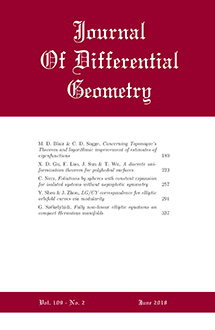Abstract
We introduce quasi-symplectic groupoids and explain their relation with momentum map theories. This approach enables us to unify into a single framework various momentum map theories, including ordinary Hamiltonian $G$-spaces, Lu's momentum maps of Poisson group actions, and the group-valued momentum maps of Alekseev–Malkin–Meinrenken. More precisely, we carry out the following program:
(1) We define and study properties of quasi-symplectic groupoids.
(2) We study the momentum map theory defined by a quasi-symplectic groupoid $\Gamma \rightrightarrows P$. In particular, we study the reduction theory and prove that $J^{-1} \mathcal {O})/ \Gamma$ is a symplectic manifold for any Hamiltonian $\Gamma$-space $(X \stackrel {J} \rightarrow P, \omega_X$ (even though $\omega_X \in \Omega^2 (X)$ may be degenerate), where $\mathcal{O} \in P$ is a groupoid orbit. More generally, we prove that the intertwiner space $(X_1 \times_{P} \overline{X_2}$ between two Hamiltonian $\Gamma$-spaces $X_1$ and $X_2$ is a symplectic manifold (whenever it is a smooth manifold).
(3) We study Morita equivalence of quasi-symplectic groupoids. In particular, we prove that Morita equivalent quasi-symplectic groupoids give rise to equivalent momentum map theories. Moreover the intertwiner space $(X_1 \times_P \overline{X_2}$depends only on the Morita equivalence class. As a result, we recover various well-known results concerning equivalence of momentum maps including the Alekseev–Ginzburg–Weinstein linearization theorem and the Alekseev–Malkin–Meinrenken equivalence theorem between quasi-Hamiltonian spaces and Hamiltonian loop group spaces.
Citation
Ping Xu. "Momentum Maps and Morita Equivalence." J. Differential Geom. 67 (2) 289 - 333, June 2004. https://doi.org/10.4310/jdg/1102536203
Information





